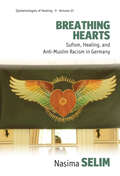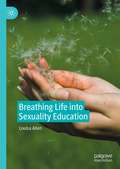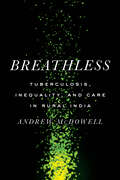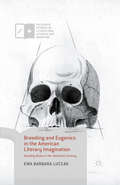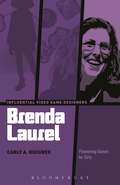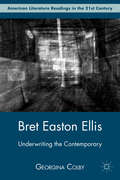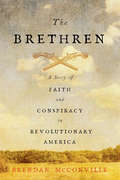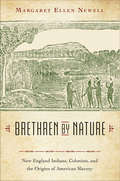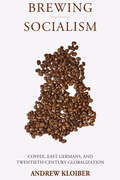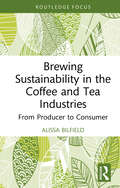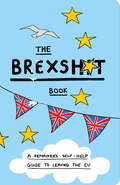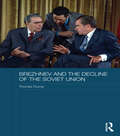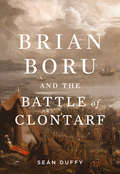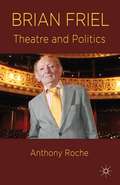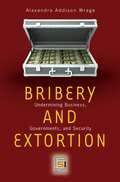- Table View
- List View
Breathing Hearts: Sufism, Healing, and Anti-Muslim Racism in Germany (Epistemologies of Healing #21)
by Nasima SelimSufism is known as the mystical dimension of Islam. Breathing Hearts explores this definition to find out what it means to ‘breathe well’ along the Sufi path in the context of anti-Muslim racism. It is the first book-length ethnographic account of Sufi practices and politics in Berlin and describes how Sufi practices are mobilized in healing secular and religious suffering. It tracks the Desire Lines of multi-ethnic immigrants of color, and white German interlocutors to show how Sufi practices complicate the post secular imagination of healing in Germany.
Breathing Hearts: Sufism, Healing, and Anti-Muslim Racism in Germany (Epistemologies of Healing #21)
by Nasima SelimSufism is known as the mystical dimension of Islam. Breathing Hearts explores this definition to find out what it means to ‘breathe well’ along the Sufi path in the context of anti-Muslim racism. It is the first book-length ethnographic account of Sufi practices and politics in Berlin and describes how Sufi practices are mobilized in healing secular and religious suffering. It tracks the Desire Lines of multi-ethnic immigrants of color, and white German interlocutors to show how Sufi practices complicate the post secular imagination of healing in Germany.
Breathing Hearts: Sufism, Healing, and Anti-Muslim Racism in Germany (Epistemologies of Healing #21)
by Nasima SelimSufism is known as the mystical dimension of Islam. Breathing Hearts explores this definition to find out what it means to ‘breathe well’ along the Sufi path in the context of anti-Muslim racism. It is the first book-length ethnographic account of Sufi practices and politics in Berlin and describes how Sufi practices are mobilized in healing secular and religious suffering. It tracks the Desire Lines of multi-ethnic immigrants of color, and white German interlocutors to show how Sufi practices complicate the post secular imagination of healing in Germany.
Breathing in Manhattan: Carola Speads - The German Jewish Gymnastics Instructor Who Brought Mindfulness to America (Edition Kulturwissenschaft #287)
by Christoph RibbatIn 1938 gymnastics instructor Carola Spitz escaped from Nazi Germany. In New York she turned into Carola Speads, revered teacher of mindfulness. She breathed with clients in her Central Park West studio until she was 97 years old. Now Christoph Ribbat combines her gripping biography with the histories of modern bodywork and breathing experiments. He illuminates the tension between self-help fads and 20th century catastrophes. Accessible and quirky, Breathing in Manhattan speaks to experts and non-experts alike: to readers of Jewish history, students of New York City, and to anyone attracted by - or skeptical of - the promises of mindfulness.
Breathing Life into Sexuality Education
by Louisa AllenThis book seeks to re-envision the purpose and pedagogy of sexuality education, disrupting its conventional instrumental and health related aims. Predominately theoretical in nature, it presses at the traditional limits of sexuality education’s thought by drawing together ideas from disparate disciplinary fields including education, geography, sound studies and new materialist theory. The philosophical thought of Sharon Todd provides an anchor throughout, and is employed to reconceptualize sexuality education as sensuous event. The author calls for a reframing of the relationship of education and ethics, and explores what this means for sexuality education classrooms and relationships between and amongst teachers and students. The book explores pedagogies that invite new forms of student sensibility and open possibilities for engagement in sexuality education in currently uncharted ways. It will appeal to students and experienced academics conducting research related to sexuality, education, educational philosophy, queer studies and new materialisms.
Breathless: Tuberculosis, Inequality, and Care in Rural India (South Asia in Motion)
by Andrew McDowellEach year in India more than two million people fall sick with tuberculosis (TB), an infectious, airborne, and potentially deadly lung disease. The country accounts for almost 30 percent of all TB cases worldwide and well above a third of global deaths from it. Because TB's prevalence also indicates unfulfilled development promises, its control is an important issue of national concern, wrapped up in questions of postcolonial governance. Drawing on long-term ethnographic engagement with a village in North India and its TB epidemic, Andrew McDowell tells the stories of socially marginalized Dalit ("ex-untouchable") farming families afflicted by TB, and the nurses, doctors, quacks, mediums, and mystics who care for them. Each of the book's chapters centers on a material or metaphorical substance—such as dust, clouds, and ghosts—to understand how breath and airborne illness entangle biological and social life in everyday acts of care for the self, for others, and for the environment. From this raft of stories about the ways people make sense of and struggle with troubled breath, McDowell develops a philosophy and phenomenology of breathing that attends to medical systems, patient care, and health justice. He theorizes that breath—as an intersection between person and world—provides a unique perspective on public health and inequality. Breath is deeply intimate and personal, but also shared and distributed. Through it all, Breathless traces the multivalent relations that breath engenders between people, environments, social worlds, and microbes.
Breathless: Tuberculosis, Inequality, and Care in Rural India (South Asia in Motion)
by Andrew McDowellEach year in India more than two million people fall sick with tuberculosis (TB), an infectious, airborne, and potentially deadly lung disease. The country accounts for almost 30 percent of all TB cases worldwide and well above a third of global deaths from it. Because TB's prevalence also indicates unfulfilled development promises, its control is an important issue of national concern, wrapped up in questions of postcolonial governance. Drawing on long-term ethnographic engagement with a village in North India and its TB epidemic, Andrew McDowell tells the stories of socially marginalized Dalit ("ex-untouchable") farming families afflicted by TB, and the nurses, doctors, quacks, mediums, and mystics who care for them. Each of the book's chapters centers on a material or metaphorical substance—such as dust, clouds, and ghosts—to understand how breath and airborne illness entangle biological and social life in everyday acts of care for the self, for others, and for the environment. From this raft of stories about the ways people make sense of and struggle with troubled breath, McDowell develops a philosophy and phenomenology of breathing that attends to medical systems, patient care, and health justice. He theorizes that breath—as an intersection between person and world—provides a unique perspective on public health and inequality. Breath is deeply intimate and personal, but also shared and distributed. Through it all, Breathless traces the multivalent relations that breath engenders between people, environments, social worlds, and microbes.
Breeding and Eugenics in the American Literary Imagination: Heredity Rules in the Twentieth Century (Palgrave Studies in Literature, Science and Medicine)
by Ewa Barbara LuczakA disturbing but ultimately discredited strain in American thought, eugenics was a crucial ideological force in the early twentieth century. Luczak investigates the work of writers like Jack London and Charlotte Perkins Gilman, to consider the impact of eugenic racial discourse on American literary production from 1900-1940.
Brenda Laurel: Pioneering Games for Girls (Influential Video Game Designers)
by Carly A. KocurekBrenda Laurel is best known for her work with Purple Moon, the pioneering game company she cofounded in the 1990s. Purple Moon's games were based on years of research Laurel completed in an effort to understand why computer games seemed to be of so little interest to girls. Using diverse archival sources such as trade journals, newspapers, and recorded interviews, alongside Laurel's completed games and own writings and an original interview with Laurel herself, this volume offers insight into both the early development of the games for girls movement of the 1990s and the lasting impact of Laurel's game design breakthroughs. In her work with Purple Moon, Laurel drew on her background in theatre as well as her expertise in human computer interaction and qualitative research. By relying on this interdisciplinary background, Laurel made significant contributions to our understanding of the design and development of games as a medium for emotional rehearsal and storytelling. Additionally, her dedication to research-informed design has had a longstanding impact as companies and designers increasingly rely on audience research and metrics to shape their practices. The newest in Bloomsbury's Influential Video Game Designers series, Carly Kocurek highlights the contributions of a designer whose work has had a profound impact on the development of both games for girls and empathy games.
Brenda Laurel: Pioneering Games for Girls (Influential Video Game Designers)
by Carly A. KocurekBrenda Laurel is best known for her work with Purple Moon, the pioneering game company she cofounded in the 1990s. Purple Moon's games were based on years of research Laurel completed in an effort to understand why computer games seemed to be of so little interest to girls. Using diverse archival sources such as trade journals, newspapers, and recorded interviews, alongside Laurel's completed games and own writings and an original interview with Laurel herself, this volume offers insight into both the early development of the games for girls movement of the 1990s and the lasting impact of Laurel's game design breakthroughs. In her work with Purple Moon, Laurel drew on her background in theatre as well as her expertise in human computer interaction and qualitative research. By relying on this interdisciplinary background, Laurel made significant contributions to our understanding of the design and development of games as a medium for emotional rehearsal and storytelling. Additionally, her dedication to research-informed design has had a longstanding impact as companies and designers increasingly rely on audience research and metrics to shape their practices. The newest in Bloomsbury's Influential Video Game Designers series, Carly Kocurek highlights the contributions of a designer whose work has had a profound impact on the development of both games for girls and empathy games.
Bret Easton Ellis: Underwriting the Contemporary (American Literature Readings in the 21st Century)
by G. ColbyThis book reads the whole of Bret Easton Ellis's oeuvre to date from Less Than Zero to Imperial Bedrooms and asks to what extent Ellis's novels can be read as critiquing the cultural moments of which they are a part. Ellis's work can be thought of as an enactment of a process of underwriting contemporary culture, which offers new paths of understanding and ways of critiquing the contemporary author's place in the relations of production.
The Brethren: A Story of Faith and Conspiracy in Revolutionary America
by Brendan McConvilleThe dramatic account of a Revolutionary-era conspiracy in which a band of farmers opposed to military conscription and fearful of religious persecution plotted to kill the governor of North Carolina. Less than a year into the American Revolution, a group of North Carolina farmers hatched a plot to assassinate the colony’s leading patriots, including the governor. The scheme became known as the Gourd Patch or Llewellen Conspiracy. The men called themselves the Brethren. The Brethren opposed patriot leaders’ demand for militia volunteers and worried that “enlightened” deist principles would be enshrined in the state constitution, displacing their Protestant faith. The patriots’ attempts to ally with Catholic France only exacerbated the Brethren’s fears of looming heresy. Brendan McConville follows the Brethren as they draw up plans for violent action. After patriot militiamen threatened to arrest the Brethren as British sympathizers in the summer of 1777, the group tried to spread false rumors of a slave insurrection in hopes of winning loyalist support. But a disaffected insider denounced the movement to the authorities, and many members were put on trial. Drawing on contemporary depositions and legal petitions, McConville gives voice to the conspirators’ motivations, which make clear that the Brethren did not back the Crown but saw the patriots as a grave threat to their religion. Part of a broader Southern movement of conscription resistance, the conspiracy compels us to appreciate the full complexity of public opinion surrounding the Revolution. Many colonists were neither loyalists nor patriots and came to see the Revolutionary government as coercive. The Brethren tells the dramatic story of ordinary people who came to fear that their Revolutionary leaders were trying to undermine religious freedom and individual liberty—the very causes now ascribed to the Founding generation.
Brethren by Nature: New England Indians, Colonists, and the Origins of American Slavery
by Margaret Ellen NewellIn Brethren by Nature, Margaret Ellen Newell reveals a little-known aspect of American history: English colonists in New England enslaved thousands of Indians. Massachusetts became the first English colony to legalize slavery in 1641, and the colonists’ desire for slaves shaped the major New England Indian wars, including the Pequot War of 1637, King Philip’s War of 1675–76, and the northeastern Wabanaki conflicts of 1676–1749. When the wartime conquest of Indians ceased, New Englanders turned to the courts to get control of their labor, or imported Indians from Florida and the Carolinas, or simply claimed free Indians as slaves. Drawing on letters, diaries, newspapers, and court records, Newell recovers the slaves’ own stories and shows how they influenced New England society in crucial ways. Indians lived in English homes, raised English children, and manned colonial armies, farms, and fleets, exposing their captors to Native religion, foods, and technology. Some achieved freedom and power in this new colonial culture, but others experienced violence, surveillance, and family separations. Newell also explains how slavery linked the fate of Africans and Indians. The trade in Indian captives connected New England to Caribbean and Atlantic slave economies. Indians labored on sugar plantations in Jamaica, tended fields in the Azores, and rowed English naval galleys in Tangier. Indian slaves outnumbered Africans within New England before 1700, but the balance soon shifted. Fearful of the growing African population, local governments stripped Indian and African servants and slaves of legal rights and personal freedoms. Nevertheless, because Indians remained a significant part of the slave population, the New England colonies did not adopt all of the rigid racial laws typical of slave societies in Virginia and Barbados. Newell finds that second- and third-generation Indian slaves fought their enslavement and claimed citizenship in cases that had implications for all enslaved peoples in eighteenth-century America.
Brewing Socialism: Coffee, East Germans, and Twentieth-Century Globalization (Studies in German History #27)
by Andrew KloiberPlacing coffee at the center of its analysis, Brewing Socialism links East Germany’s consumption and food culture to its relationship to the wider world. Andrew Kloiber reveals the ways that everyday cultural practices surrounding coffee drinking not only connected East Germans to a global system of exchange, but also perpetuated a set of traditions and values which fit uneasily into the Socialist Unity Party’s conceptualization of a modern Socialist Utopia. Sifting through the relationship between material culture and ideology, this unique work examines the complex tapestry of traditions, history and cultural values that underpinned the socialist German Democratic Republic (GDR).
Brewing Socialism: Coffee, East Germans, and Twentieth-Century Globalization (Studies in German History #27)
by Andrew KloiberPlacing coffee at the center of its analysis, Brewing Socialism links East Germany’s consumption and food culture to its relationship to the wider world. Andrew Kloiber reveals the ways that everyday cultural practices surrounding coffee drinking not only connected East Germans to a global system of exchange, but also perpetuated a set of traditions and values which fit uneasily into the Socialist Unity Party’s conceptualization of a modern Socialist Utopia. Sifting through the relationship between material culture and ideology, this unique work examines the complex tapestry of traditions, history and cultural values that underpinned the socialist German Democratic Republic (GDR).
Brewing Sustainability in the Coffee and Tea Industries: From Producer to Consumer (Earthscan Food and Agriculture)
by Alissa BilfieldThis book focuses on the often intertwined industries of coffee and tea, using accounts of single producer communities to highlight the transformation from plantation-style colonial agriculture towards systems that now claim to produce social and environmental benefits from the farm to the cup. Focusing on the dynamics of farmers' experiences producing coffee and tea ethically and sustainably at origin, the book shows how these values are transmitted and reinforced throughout the value chain. Exploring tandem case studies of fair trade cooperatives in Guatemala and Sri Lanka, it provides an insight into the creation of more sustainable value chains from producer to consumer in the global marketplace, incorporating the perspectives of coffee exporters, importers, roasters, and café owners. This book is focused on the prospects of the specialty movement in food as a catalyst for forging more authentic, just, and sustainable supply chains that consider both people and the environment. This book will be of great interest to students and scholars of food and agriculture, sustainable food systems and supply chains, the fair trade movement, sustainable development, and social entrepreneurship and social innovation.
Brewing Sustainability in the Coffee and Tea Industries: From Producer to Consumer (Earthscan Food and Agriculture)
by Alissa BilfieldThis book focuses on the often intertwined industries of coffee and tea, using accounts of single producer communities to highlight the transformation from plantation-style colonial agriculture towards systems that now claim to produce social and environmental benefits from the farm to the cup. Focusing on the dynamics of farmers' experiences producing coffee and tea ethically and sustainably at origin, the book shows how these values are transmitted and reinforced throughout the value chain. Exploring tandem case studies of fair trade cooperatives in Guatemala and Sri Lanka, it provides an insight into the creation of more sustainable value chains from producer to consumer in the global marketplace, incorporating the perspectives of coffee exporters, importers, roasters, and café owners. This book is focused on the prospects of the specialty movement in food as a catalyst for forging more authentic, just, and sustainable supply chains that consider both people and the environment. This book will be of great interest to students and scholars of food and agriculture, sustainable food systems and supply chains, the fair trade movement, sustainable development, and social entrepreneurship and social innovation.
The Brexshit Book
by Steven S. StevensThis is the book for the 16 Million of us that woke up the day after the night before the EU referendum to find our Euro dreams in tatters. This is a book about leaving when you really wanted to stay. This is a book about having to deal with the consequences of someone else's decision. This is a book that will lead you mindfully (and not without some good hearted political mockery) down the path of acceptance into the cold hard Brexit dawn.
Brezhnev and the Decline of the Soviet Union (Routledge Studies in the History of Russia and Eastern Europe)
by Thomas CrumpLeonid Brezhnev was leader of the Soviet Union from 1964-1982, a longer period than any other Soviet leader apart from Stalin. During Brezhnev’s time Soviet power seemed at its height and increasing. Living standards were rising, the Soviet Union was a nuclear power and successful in its space missions, and the Soviet Union's influence reached into all part of the world. Yet, as this book, which provides a comprehensive overview and reassessment of Brezhnev’s life, early political career and career as leader, shows, the seeds of decline were sown in Brezhnev's time. There was a huge over-commitment of resources to the Soviet industrial-military complex and to massively expensive foreign policy overstretch. At the same time there was a failure to deliver on citizens' rising expectations, and an overconfident ignoring of dissidents and their demands. The book will be of great interest to Russian specialists, and also to scholars of international relations and world history.
Brezhnev and the Decline of the Soviet Union: Brezhnev And The Decline Of The Soviet Union (Routledge Studies in the History of Russia and Eastern Europe)
by Thomas CrumpLeonid Brezhnev was leader of the Soviet Union from 1964-1982, a longer period than any other Soviet leader apart from Stalin. During Brezhnev’s time Soviet power seemed at its height and increasing. Living standards were rising, the Soviet Union was a nuclear power and successful in its space missions, and the Soviet Union's influence reached into all part of the world. Yet, as this book, which provides a comprehensive overview and reassessment of Brezhnev’s life, early political career and career as leader, shows, the seeds of decline were sown in Brezhnev's time. There was a huge over-commitment of resources to the Soviet industrial-military complex and to massively expensive foreign policy overstretch. At the same time there was a failure to deliver on citizens' rising expectations, and an overconfident ignoring of dissidents and their demands. The book will be of great interest to Russian specialists, and also to scholars of international relations and world history.
Brian Boru and the Battle of Clontarf
by Sean DuffyBrian Boru is the most famous Irish person before the modern era, whose death at the Battle of Clontarf in 1014 is one of the few events in the whole of Ireland’s medieval history to retain a place in the popular imagination. Once, we were told that Brian, the great Christian king, gave his life in a battle on Good Friday against pagan Viking enemies whose defeat banished them from Ireland forever. More recent interpretations of the Battle of Clontarf have played down the role of the Vikings and portrayed it as merely the final act in a rebellion against Brian, the king of Munster, by his enemies in Leinster and Dublin. This book proposes a far-reaching reassessment of Brian Boru and Clontarf. By examining Brian’s family history and tracing his career from its earliest days, it uncovers the origins of Brian’s greatness and explains precisely how he changed Irish political life forever. Brian Boru and the Battle of Clontarf offers a new interpretation of the role of the Vikings in Irish affairs and explains how Brian emerged from obscurity to attain the high-kingship of Ireland because of his exploitation of the Viking presence. And it concludes that Clontarf was deemed a triumph, despite Brian’s death, because of what he averted – a major new Viking offensive in Ireland – on that fateful day.
Brian Eno's Ambient 1: Music for Airports (The Oxford Keynotes Series)
by John T. LysakerBrian Eno's seminal album Ambient 1: Music for Airports continues to fascinate and charm audiences, not only as a masterpiece of ambient music, but as a powerful and transformative work of art. Author John T. Lysaker situates this album in the context of twentieth-century art music, where its ambitions and contributions to avant garde music practice become even more apparent. To appreciate the album's multifaceted character, Lysaker advocates for "prismatic listening," an attentiveness that continually shifts registers in the knowledge that no single approach can grasp the work as a whole. Exploring each of the album's four tracks and their unique sonic arrangements, Brian Eno's Ambient 1: Music for Airports argues that the album must be approached from at least three angles: as an ambient contribution to lived environments that draws upon cybernetics and the experiments of Erik Satie, as an exploration of what John Cage has termed the "activity of sounds," and as a work of conceptual art that asks us to think freshly about artistic creativity, listening, and the broad ecology of interactions that not only make art possible, but the full range of human meaning. If one listens in this way, Music for Airports becomes a sonic image that blurs the nature-culture distinction and rescues the most interesting concerns of avant-garde music from the social isolation of concert halls and performance spaces.
BRIAN ENO'S AMBIENT 1 OKS C (The Oxford Keynotes Series)
by John T. LysakerBrian Eno's seminal album Ambient 1: Music for Airports continues to fascinate and charm audiences, not only as a masterpiece of ambient music, but as a powerful and transformative work of art. Author John T. Lysaker situates this album in the context of twentieth-century art music, where its ambitions and contributions to avant garde music practice become even more apparent. To appreciate the album's multifaceted character, Lysaker advocates for "prismatic listening," an attentiveness that continually shifts registers in the knowledge that no single approach can grasp the work as a whole. Exploring each of the album's four tracks and their unique sonic arrangements, Brian Eno's Ambient 1: Music for Airports argues that the album must be approached from at least three angles: as an ambient contribution to lived environments that draws upon cybernetics and the experiments of Erik Satie, as an exploration of what John Cage has termed the "activity of sounds," and as a work of conceptual art that asks us to think freshly about artistic creativity, listening, and the broad ecology of interactions that not only make art possible, but the full range of human meaning. If one listens in this way, Music for Airports becomes a sonic image that blurs the nature-culture distinction and rescues the most interesting concerns of avant-garde music from the social isolation of concert halls and performance spaces.
Brian Friel: Theatre and Politics (Cambridge Companions To Literature Ser.)
by A. RocheFriel is recognised as Ireland's leading playwright and due to the ability of plays like Translations and Dancing at Lughnasa to translate into other cultures he has made a major impact on world theatre. This study draws on the Friel Archive to deepen our understanding of how his plays were developed.
Bribery and Extortion: Undermining Business, Governments, and Security (Praeger Security International)
by Alexandra Addison WrageBribery plays a significant role in international criminal activity. Terrorists pay bribes. Money-launderers pay bribes. Those who traffic in people, narcotics, and illegal arms pay bribes. People pay immigration officers not to ask, customs officials not to inspect, and police officers not to investigate. Bribes follow patterns that are not at all mysterious to the officials, salesmen, and citizens who seek them and pay them. Using a series of international cases, Wrage examines bribery, peeling back the mystique and ambiguity and exposing the very simple transactions that lie beneath. She shows how these seemingly everyday transactions can affect security, democratization, and human aid. Examples from around the world help to illustrate the nature of the problem and efforts at combating it.Bribery plays a significant role in international criminal activity. Terrorists pay bribes. Money-launderers pay bribes. Those who traffic in people, narcotics, and illegal arms pay bribes. People pay immigration officers not to ask, customs officials not to inspect, and police officers not to investigate. At corporate headquarters in the United States, it can be easy to dismiss modest bribes in distant countries as an unfortunate cost of doing business. Bribes follow patterns that are not at all mysterious to the officials, salesmen, and citizens who seek them and pay them. Using a series of international cases, Wrage examines bribery, peeling back the mystique and ambiguity and exposing the very simple transactions that lie beneath. She shows how these seemingly everyday transactions can affect security, democratization, and human aid around the globe.Bribery and Extortion presents a clear picture of the world of bribery and the havoc it can wreak on whole populations. Wrage covers commercial bribery, administrative and service-based bribery, and extortion. She considers bribery and extortion at both high levels of government and lower levels on the street. Examples from around the world help to illustrate the nature of the problem and efforts at combating it. The book concludes with practical suggestions and an assessment of current efforts to stem the tide of bribery and restore transparency to everyday transactions in all realms.
